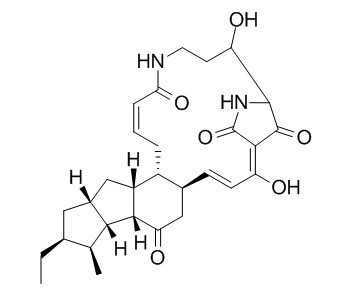Xanthobaccin A
Xanthobaccin A, an antifungal compound, plays a key role in suppression of sugar beet damping-off disease.
Inquire / Order:
manager@chemfaces.com
Technical Inquiries:
service@chemfaces.com
Tel:
+86-27-84237783
Fax:
+86-27-84254680
Address:
1 Building, No. 83, CheCheng Rd., Wuhan Economic and Technological Development Zone, Wuhan, Hubei 430056, PRC
Providing storage is as stated on the product vial and the vial is kept tightly sealed, the product can be stored for up to
24 months(2-8C).
Wherever possible, you should prepare and use solutions on the same day. However, if you need to make up stock solutions in advance, we recommend that you store the solution as aliquots in tightly sealed vials at -20C. Generally, these will be useable for up to two weeks. Before use, and prior to opening the vial we recommend that you allow your product to equilibrate to room temperature for at least 1 hour.
Need more advice on solubility, usage and handling? Please email to: service@chemfaces.com
The packaging of the product may have turned upside down during transportation, resulting in the natural compounds adhering to the neck or cap of the vial. take the vial out of its packaging and gently shake to let the compounds fall to the bottom of the vial. for liquid products, centrifuge at 200-500 RPM to gather the liquid at the bottom of the vial. try to avoid loss or contamination during handling.
Preprints2017, 2017120176
Pharmaceutics.2022, 14(5):945.
J Am Soc Mass Spectrom.2021, 32(5):1205-1214.
J Pharmacol Sci.2021, 147(2):184-191.
Eur J Pharmacol.2024, 978:176749.
Int J Mol Sci.2021, 22(21):11836.
Korean J Acupunct2020, 37:104-121
Biology (Basel).2020, 9(11):363.
Fitoterapia.2021, 153:104995.
Free Radic Biol Med.2016, 97:307-319
Related and Featured Products
Appl Environ Microbiol. 1999 Oct;65(10):4334-9.
Possible role of xanthobaccins produced by Stenotrophomonas sp. strain SB-K88 in suppression of sugar beet damping-off disease.[Pubmed:
10508056]
Three antifungal compounds, designated xanthobaccins A, B, and C, were isolated from the culture fluid of Stenotrophomonas sp. strain SB-K88, a rhizobacterium of sugar beet that suppresses damping-off disease.
METHODS AND RESULTS:
Production of Xanthobaccin A in culture media was compared with the disease suppression activities of strain SB-K88 and less suppressive strains that were obtained by subculturing. Strain SB-K88 was applied to sugar beet seeds, and production of Xanthobaccin A in the rhizosphere of seedlings was confirmed by using a test tube culture system under hydroponic culture conditions; 3 microg of Xanthobaccin A was detected in the rhizosphere on a per-plant basis. Direct application of purified Xanthobaccin A to seeds suppressed damping-off disease in soil naturally infested by Pythium spp.
CONCLUSIONS:
We suggest that Xanthobaccin A produced by strain SB-K88 plays a key role in suppression of sugar beet damping-off disease.
Appl Environ Microbiol. 2005 Jul;71(7):3786-96.
Suppression of damping-off disease in host plants by the rhizoplane bacterium Lysobacter sp. strain SB-K88 is linked to plant colonization and antibiosis against soilborne Peronosporomycetes.[Pubmed:
16000790]
METHODS AND RESULTS:
We previously demonstrated that Xanthobaccin A from the rhizoplane bacterium Lysobacter sp. strain SB-K88 suppresses damping-off disease caused by Pythium sp. in sugar beet. Interestingly, zoospores of A. cochlioides became immotile within 1 min after exposure to a SB-K88 cell suspension, a cell-free supernatant of SB-K88, or pure Xanthobaccin A (MIC, 0.01 microg/ml). In all cases, lysis followed within 30 min in the presence of the inhibiting factor(s).
CONCLUSIONS:
Our data indicate that Lysobacter sp. strain SB-K88 has a direct inhibitory effect on A. cochlioides, suppressing damping-off disease. Furthermore, this inhibitory effect of Lysobacter sp. strain SB-K88 is likely due to a combination of antibiosis and characteristic biofilm formation at the rhizoplane of the host plant.



